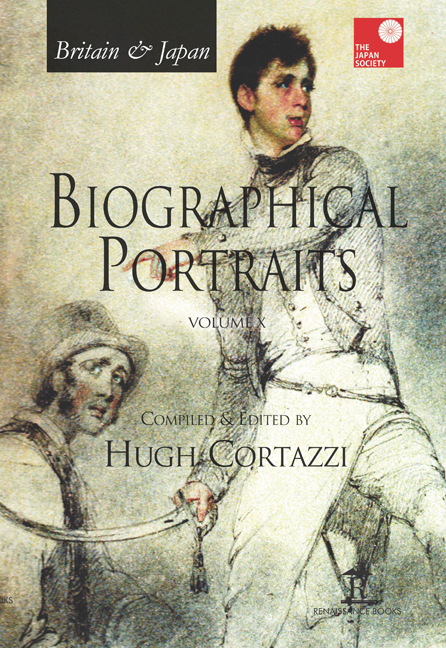Book contents
- Frontmatter
- Dedication
- Contents
- Introduction
- List of Contributors
- Index of Biographical Portraits in Japan Society Volumes
- PART I BRITAIN IN JAPAN
- PART II JAPAN IN BRITAIN
- Select Bibliography of Works in English on Anglo-Japanese Relations [Compiled by Gill Goddard – Retired East Asian Studies Librarian, University of Sheffield]
- Select Bibliography of Works in Japanese on Anglo-Japanese Relations [Compiled by Akira Hirano, SISJAC]
- Index
55 - The Japanese Chamber of Commerce in the UK, 1959–2015
Published online by Cambridge University Press: 07 May 2022
- Frontmatter
- Dedication
- Contents
- Introduction
- List of Contributors
- Index of Biographical Portraits in Japan Society Volumes
- PART I BRITAIN IN JAPAN
- PART II JAPAN IN BRITAIN
- Select Bibliography of Works in English on Anglo-Japanese Relations [Compiled by Gill Goddard – Retired East Asian Studies Librarian, University of Sheffield]
- Select Bibliography of Works in Japanese on Anglo-Japanese Relations [Compiled by Akira Hirano, SISJAC]
- Index
Summary
A SERIOUS JAPANESE business presence in London started in the late-nineteenth century with the establishment of individual Japanese company offices, including trading companies. For example, Mitsui & Co.'s office was set up in 1880 initially to export surplus Japanese rice to Europe. Mitsubishi Corporation's London office came later in 1915. The Yokohama Specie Bank (the precursor of the Bank of Tokyo, now Bank of Tokyo Mitsubishi UFJ) sent a representative to London in 1881. Tokio Marine, the insurance firm, opened a London office in 1880. The small Japanese business community, with about sixteen offices in London before the First World War, grew to thirty-seven companies (twenty-seven of them trading companies) by 1919 because of the increase in Anglo-Japanese trade during the war.
The first formal organisation of Japanese businesses in London seems to have been the Japanese Businessmen's Association (London Shōgyō Konwa-Kai), which operated in the 1920s and 1930s to discuss common problems and issues among Japanese businessmen. Another indication of Japanese interest in collective business organisation was the appointment in 1932 of Hotta Naomichi, a prominent member of the Japanese business community in London, as Secretary to the Japan Committee of the International Chamber of Commerce (ICC), a position, which kept him in contact with managers of the major Japanese firms, in the inter-war period. However, the Nihonjin-Kai (predecessor of the Nippon Club5), the general social club for the Japanese community, continued as the main collective focus for Japanese businessmen, with many playing an active role in it.
The Japanese business presence in the UK, which had grown to 400 or 500 business people in the inter-war period, was then disrupted by the outbreak of war between Britain and Japan with Anglo-Japanese business declining as war loomed and then being extinguished by internment and repatriation of Japanese expatriates.
After the Second World War, relations between Britain and Japan gradually developed again. The San Francisco Peace Treaty between Japan and the Allied Powers, signed in 1951, came into force in 1952 and the Japanese Embassy was established again in London. Japanese businesses, especially trading, shipping, insurance companies and banks, started to set up offices anew in the UK in the early 1950s. Hotta resumed his work for the ICC's Japan Committee and re-launched the Palmerston Kai, a monthly luncheon meeting of the general managers of Japanese companies. A key development in normalising UK-Japan business relations was the UK-Japan Commercial Treaty of November 1962, negotiated over many years and concluded against a background of phenomenal growth in the Japanese economy, with British understanding of the need to have access to its markets and mutual agreement on the need to remove trade discrimination.
The Japanese Chamber of Commerce in London was incorporated on 14 July 1959 as a company limited by guarantee and not having a share capital. Seven Japanese businessmen were listed as subscribers: Miwa Kinji, Takuma Michio, Matsudaira Ichirō, Nakamura Mototaka, Miwa Hiroshi, Homma Jiro and Hanai Takao. We have a few glimpses of these men. The most prominent was Matsudaira Ichirō. Born in London, he was the son of Matsudaira Tsuneo, the longest serving Japanese ambassador in the UK. He was the brother of Matsudaira Setsuko who had married Prince Chichibu in 1928. He had married into the Tokugawa family. He represented the Bank of Tokyo in London and, in 1960 shortly after the establishment of the Japanese Chamber, became the first Chairman of the newly re-established Nippon Club, which was set up by about fifty companies and 250 individuals.
- Type
- Chapter
- Information
- Britain & Japan Biographical Portraits Vol X , pp. 612 - 624Publisher: Amsterdam University PressPrint publication year: 2016

